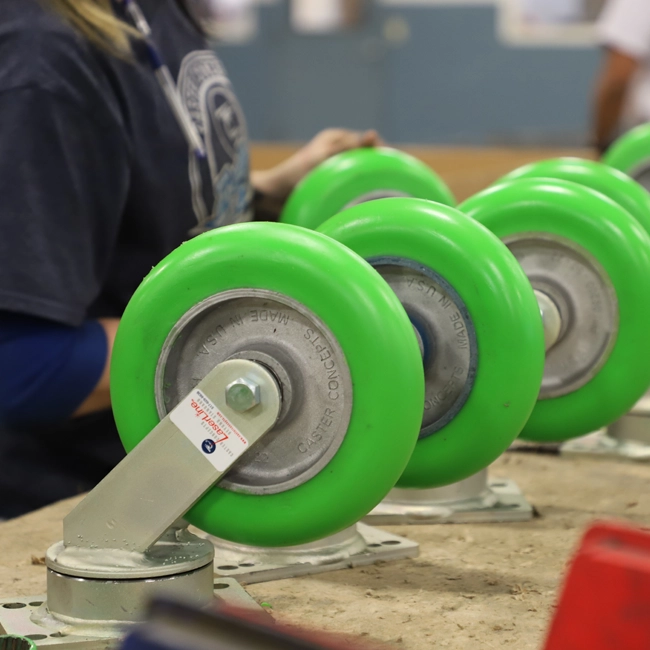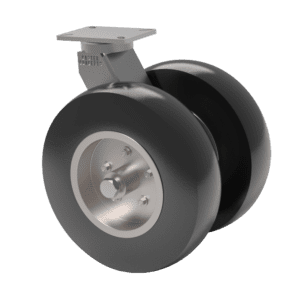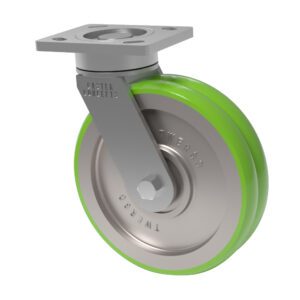

There are dozens of wheel and material options available to you in your caster journey, and two of the most popular are poly (short for polyurethane) and classic rubber (pneumatic).
Understanding the differences between these can be an essential step in helping you determine whether poly wheels or rubber wheels will best suit your needs.
Both caster types serve distinct purposes, and their selection hinges on specific application needs. Understanding their characteristics enables us to optimize performance, extend equipment lifespan, and ensure safe operations.
| Property | Pneumatic Casters | Polyurethane Casters |
| Wear and Tear | Fair | Excellent |
| Load Capacity | Good | Excellent |
| Floor Marking | Fair | Excellent |
| Rolling Resistance | Higher | Lower |
| Traction | Excellent | Good Indoors |
| Cushioning | Excellent | Fair |
| Price | Slightly Higher | Lower Cost |

Pneumatic wheel
Pneumatic caster wheels, or unpowered air-filled wheels, are named “pneumatic” due to their operation under air pressure. The wheel, made from a rubber polymer, is hollow and air-filled, attached to a metal or alloy frame. Typically having four or more threaded holes, the frame is bolted onto the object’s underside to install these casters. Once installed, they enable easy rolling of the object and give pneumatic caster wheels their simple description: air-filled wheels on a mounting frame.
The weight capacities of pneumatic caster wheels range from 300-7000 lbs.
Shock Absorption
Pneumatic caster wheels demonstrate superior shock absorption capabilities, ideal for rough or uneven flooring, particularly when transporting heavy or delicate loads. Using air or foam to cushion against rough terrains or irregular flooring reduces potential damage.
Versatility
Incurring additional costs by buying separate casters for indoor and outdoor use are elimiated with pneumatic caster wheels since they perform exceptionally well in both contexts.
Noise Reduction.
Pneumatic caster wheels help minimize noise pollution in the workplace. The rubber treads and shock-absorption properties of pneumatic casters help ensure a quieter roll when properly maintained.
Interchangeability
Pneumatic caster wheels display a unique engineering structure contributing to their effortless interchangeability. Characterized by a dual bolt configuration on the rim’s inner side, these wheels can be swiftly swapped out when needed. The first set of bolts ensures the secure attachment of the rim to the axle, while the second set is instrumental in affixing the wheel to the rim.
Performance on Rough Surfaces
Pneumatic tires are known for their exceptional performance on irregular and harsh terrains. Inside the tire, the contained air absorbs shocks from uneven flooring and substantially reduces the typically experienced jarring from irregularities in the terrain.
Pneumatic caster wheel are prone to punctures and wear and tear, compromising their durability. They often require more maintenance due to consistently maintaining air pressure. Moreover, their softness leads to higher rolling resistance, which can result in increased effort for maneuverability, particularly on hard surfaces.
While they absorb shock efficiently, they are not ideal for carrying heavy loads due to potential deformation. Lastly, variances in air pressure can result in inconsistent performance. They may cause instability or an unbalanced load, a critical issue in precision-oriented or sensitive environments.

Polyurethane wheel
Polyurethane is prevalent in the caster wheel industry because it combines the benefits of flexible rubber casters (resilience, grip, and shock absorption) with the advantages of hard plastic or nylon casters (wear resistance, load capacity, and resistance to various oils and solvents).
Often made from thermoset polyurethanes due to their superior properties, polyurethane casters gain enhanced strength and heat stability during the curing process. The material can be bonded chemically or mechanically to various materials, including nylon, polypropylene, steel, and aluminium.
Load-Bearing Capacity
Polyurethane caster wheels possess a significant advantage in load-bearing capacity and significantly outperform rubber wheels thanks to their increased hardness. This hardness and durability prevent undesirable occurrences, including cracking, flaking, splitting, or tearing, which makes these wheels suitable for long-term, high-demand applications.
Floor Protection
The large size of polyurethane caster wheels benefits floor conditions because they distribute weight evenly and minimize the risk of floor damage like dents, scratches, chips, or cracks. Caster Concepts also has poly wheels that are non-marking, useful when the visual appeal and integrity of flooring are essential.
Slip Resistance
In terms of safety and efficiency, polyurethane caster wheels offer superior slip resistance than other materials like metals, ensuring consistent traction and reducing the force required for movement for better ergonomics.
Resilience
Last but not least, polyurethane’s resilience is noteworthy. Its resistance to various chemicals, oils, salts, and other potentially harmful substances ensures superior performance and longevity in dynamic environments.
Polyurethane caster wheels also have some disadvantages. They possess lower heat resistance, making them susceptible to deformation or disintegration in extreme thermal environments. In high-speed operations, the rolling resistance of polyurethane wheels becomes higher and prompts decreased efficiency and increased wear.
Another factor is that the material’s inherent elasticity may lead to a “flat-spotting” issue when left under load for extended periods, compromising rollability. The right wheel can minimize these factors, so it’s important to talk to a caster expert to determine the best fit for your needs.
RELATED: Caster Wheel Polyurethane Types
When choosing between pneumatic caster wheels and polyurethane caster wheels, understanding the scenario’s load weight, floor conditions, and operational demands is fundamental to deciding on the right wheel material for your material handling application.
Questions? We are happy to help. Let’s Talk!